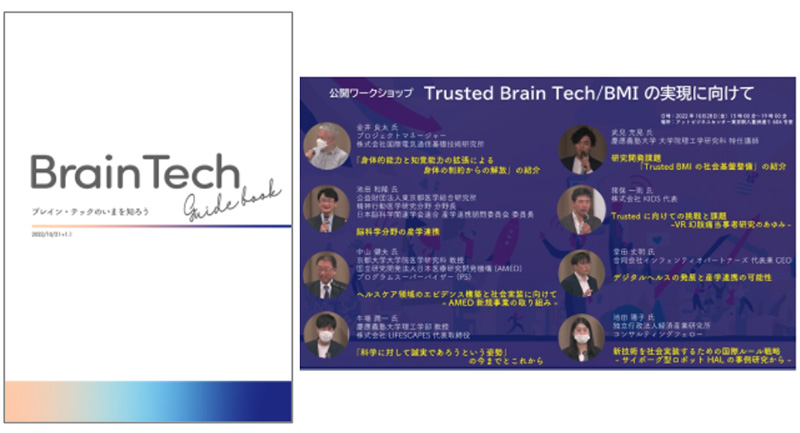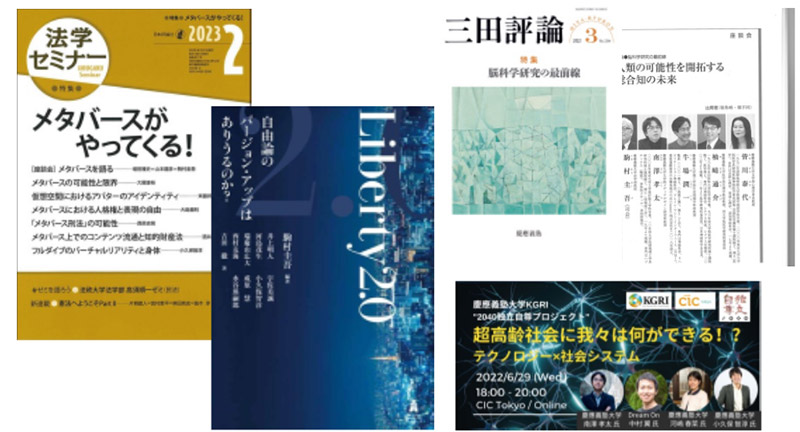Progress Report
Liberation from Biological Limitations via Physical, Cognitive and Perceptual Augmentation4. Study of issues common to the project and R&D for social implementation
Progress until FY2022
1. Outline of the project
We are establishing a foundation to facilitate the smooth progression and expansion of projects in other R&D themes. We have conducted literature-based searches and listings of novel technologies aimed at realizing Brain Assistant1 and X Communication2 applications. Among these, we are pursuing the development of new technologies in fields such as Stentrode and nanoneurobiology, and are in the process of selecting project proponents, including international research groups.
Additionally, we aim to promote a proper understanding of Brain-Machine Interface (BMI) technology by writing a Braintech Guidebook and Evidence Book for the public. We have completed the Japanese and English versions of the Guidebook, and plan to release the Evidence Book in FY2023. We also have been advancing discussions on the transformation of BMI-CA in both legal theory and practice, and have been promoting international exchange and domestic dissemination based on this research.
2. Outcome so far
Study of issues common to the project and R&D for social implementation
- To strengthen the international collaboration, we promoted participation of Professor Grayden of the University of Melbourne, Australia, who created the Stentrode.
- We have improved the prediction accuracy of brain measurement sites based on electrocorticogram (ECoG) features using deep learning and presented our findings at the Conference on Cognitive Computational Neuroscience.
Establishing the Social Infrastructure for Trusted BMI
- We created the BrainTech Guidebook, releasing the Japanese version in October 2022 and the English version in March 2023. We held a public workshop in conjunction with the release of the Japanese version, and we distributed an introductory article on the science news distribution site Eurekalert! to enhance the international presence.
- One completed systematic review3 of the efficacy and safety of BMI products was accepted for publication in a peer-reviewed English journal, and another was published on a preprint server.

Legal Considerations in the Utilization of BMI-CA
- The "Internet of Brains"-Society (IoB-S) held meetings approximately once a month to discuss the latest developments in technology and to address ELSI (Ethical, Legal, and Social Implications) issues, and prepare ELSI reports.
- We have completed a total of twelve articles in a two-year series of "Dialogues with Engineers" in the well-known law journal "Law Seminar".
- We widely publicized our research findings both domestically and internationally through numerous symposiums, conferences, and publications. For example, IoB-S hosted three open forums and organized a concurrent session at the 2023 Global Summit on Constitutionalism held at the University of Texas at Austin, where we reported on our activities and research.

3. Future plans
- As part of strengthening international collaboration, we will proceed with the selection and addition of overseas project proponents.
- We will write and publish Japanese and English versions of the Braintech Evidence Book.
- We will explore and identify new technologies to ensure the safety and reliability of AI-assisted Trusted-BMI users.
- Considering the ethical, legal, and social aspects of AI-assisted Trusted-BMI technologies, we will identify challenges in invasive, non-invasive, and non-contact technologies and develop demonstration scenarios.
- To strengthen domestic and international collaboration, we will disseminate our results by holding symposiums and workshops in Japan and abroad and by issuing publications.
- Brain Assistant: An AI-assisted BMI-CA application that helps manage health by monitoring the user's mental and physical states.
- X Communication: An AI-assisted BMI-CA application that deciphers concepts and images that come to mind, allowing users to control service robots, personal mobility devices, avatars for VR.
- systematic review: Scientific methods for systematically collecting, evaluating, and integrating the results of published studies